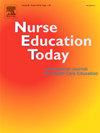The effectiveness of PechaKucha as a reinforcement tool in teaching vital signs skills to nursing students: A randomized controlled trial
IF 4.2
2区 医学
Q1 EDUCATION, SCIENTIFIC DISCIPLINES
引用次数: 0
Abstract
Aim
This study aimed to evaluate the effectiveness of the PechaKucha presentation technique as a reinforcement tool in teaching vital signs to nursing students.
Background
Vital signs education is essential in nursing training, and engaging reinforcement methods like PechaKucha may enhance retention and satisfaction, though its use in nursing remains underexplored.
Design
A randomized controlled experimental design with pre- and post-test measurements was used (Clinical Trials ID: NCT06750705).
Methods
The study was conducted between December 30, 2024, and January 10, 2025, with 92 first-year nursing students at Siirt University. Participants were randomly assigned to either the control group (PowerPoint, n = 46) or the experimental group (PechaKucha, n = 46) using block randomization. Data were collected using the Vital Signs Knowledge Test, Skills Checklist, Satisfaction Survey, and Student Feedback Form. Statistical analyses included dependent and independent samples t-tests, with effect sizes calculated using Cohen's d.
Results
While there was a significant increase in within-group knowledge scores after the training, no significant difference was found between the groups (p > 0.05). Skill scores were also similar (p > 0.05). However, the experimental group reported significantly higher satisfaction (p < 0.05, Cohen's d = 1.157). Most students found PechaKucha concise and clear (86.9 %), engaging (65.2 %), and helpful for focus (69.5 %) and retention (76.0 %).
Conclusion
The PechaKucha method can be used as an alternative to traditional PowerPoint presentations in teaching vital signs to nursing students and may increase student satisfaction. This method contributes to the learning process by reinforcing information in a visual and focused manner.
PechaKucha作为强化工具在护生生命体征技能教学中的有效性:一项随机对照试验
目的评价PechaKucha表达法在护生生命体征教学中的强化效果。背景:生命体征教育在护理培训中是必不可少的,而像PechaKucha这样的强化方法可能会提高记忆力和满意度,尽管它在护理中的应用仍未得到充分的探索。设计采用随机对照实验设计,包括测试前和测试后的测量(临床试验ID: NCT06750705)。方法研究于2024年12月30日至2025年1月10日在锡尔特大学护理一年级学生92名中进行。参与者被随机分配到对照组(PowerPoint, n = 46)或实验组(PechaKucha, n = 46)。数据收集采用生命体征知识测验、技能检查表、满意度调查和学生反馈表。统计分析包括依赖样本和独立样本t检验,使用Cohen's d.计算效应量。结果虽然训练后组内知识得分显著增加,但组间无显著差异(p > 0.05)。技能得分也相似(p > 0.05)。而实验组满意度明显高于对照组(p < 0.05, Cohen’s d = 1.157)。大多数学生认为佩查库查语简洁清晰(86.9%),引人入胜(65.2%),有助于集中注意力(69.5%)和记忆(76.0%)。结论PechaKucha方法可替代传统的PowerPoint课件进行护生生命体征教学,提高学生满意度。这种方法通过视觉和集中的方式强化信息,有助于学习过程。
本文章由计算机程序翻译,如有差异,请以英文原文为准。
求助全文
约1分钟内获得全文
求助全文
来源期刊

Nurse Education Today
医学-护理
CiteScore
6.90
自引率
12.80%
发文量
349
审稿时长
58 days
期刊介绍:
Nurse Education Today is the leading international journal providing a forum for the publication of high quality original research, review and debate in the discussion of nursing, midwifery and interprofessional health care education, publishing papers which contribute to the advancement of educational theory and pedagogy that support the evidence-based practice for educationalists worldwide. The journal stimulates and values critical scholarly debate on issues that have strategic relevance for leaders of health care education.
The journal publishes the highest quality scholarly contributions reflecting the diversity of people, health and education systems worldwide, by publishing research that employs rigorous methodology as well as by publishing papers that highlight the theoretical underpinnings of education and systems globally. The journal will publish papers that show depth, rigour, originality and high standards of presentation, in particular, work that is original, analytical and constructively critical of both previous work and current initiatives.
Authors are invited to submit original research, systematic and scholarly reviews, and critical papers which will stimulate debate on research, policy, theory or philosophy of nursing and related health care education, and which will meet and develop the journal''s high academic and ethical standards.
 求助内容:
求助内容: 应助结果提醒方式:
应助结果提醒方式:


